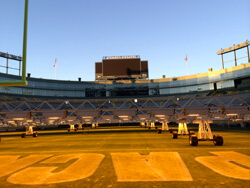 How do you grow grass on a Wisconsin football field in December? I was in Green Bay recently speaking to manufacturing executives about solutions for leveraging an aging workforce. While there, I visited that NFL shrine known as Lambeau Field, which turns out to be a great source of insights for the challenges of shrinking key skill shortages in your company.
How do you grow grass on a Wisconsin football field in December? I was in Green Bay recently speaking to manufacturing executives about solutions for leveraging an aging workforce. While there, I visited that NFL shrine known as Lambeau Field, which turns out to be a great source of insights for the challenges of shrinking key skill shortages in your company.
The Green Bay Packers are stubborn. Instead of converting their beloved Lambeau Field to artificial turf, they’ve found a way to grow grass that preserves their mythical “frozen tundra.” The Packers use a complex combination of focus, experimentation and technology to do this. Here are five lessons from the Packer’s experience relevant to closing the skills gap.
1. There’s no silver bullet!
 Lambeau Field has had heated turf (using underground pipes) for over 40 years. But warm soil was not enough to grow grass that’s strong, healthy and thick. The Packers needed sufficient warm light. Just as there is no single solution for growing grass, the same is true for developing critical skills. The elements of any solution must complement each other, whether it’s recruiting talent more creatively, more intensive employee development or better retention efforts. One initiative won’t do it. Are you pursuing an integrated approach to this problem?
Lambeau Field has had heated turf (using underground pipes) for over 40 years. But warm soil was not enough to grow grass that’s strong, healthy and thick. The Packers needed sufficient warm light. Just as there is no single solution for growing grass, the same is true for developing critical skills. The elements of any solution must complement each other, whether it’s recruiting talent more creatively, more intensive employee development or better retention efforts. One initiative won’t do it. Are you pursuing an integrated approach to this problem?
2. Be proactive in responding to the changing environment.
To sustain natural grass, the Packers had to invest in a solution that counters the effects of the weakening late fall sun. Different conditions brought on by changing seasons are inevitable. You, too, must respond to macro changes in the environment. Shifting workforce demographics and the retirement of millions of Baby Boomers, the increasingly complex skill sets needed, particularly in fields like manufacturing and healthcare, and changing values of younger workers require proactive responses to changing sources of skilled labor. Remember, “hope” is not a method when it comes to developing and retaining essential capabilities.
3. Location dictates skills gap challenges and solution options.
Lambeau’s stadium design and the recent addition of new sections of seats now prevents adequate sun light from reaching significant parts of the field. In the same way, your organization’s location and structure dictates solutions you must pursue. A small manufacturer in Milwaukee or Minneapolis has access to a different skill base and resources for developing talent than a firm in a much more rural location. My research continually shows that options for closing the skills gap are heavily dictated by your organization’s location and structure.
4. Steal solutions from other industries.
The Stadium Grow Light solution at Lambeau Field is actually adapted from a system originally designed in the Netherlands to grow roses. Many industries are working on solutions to solve essential skill shortages today. Don’t overlook innovative ideas that can come from other sectors. Click here to see a collection of recent ideas from different industries.
5. Tackle the skills gap in season.
 Despite the innovative technology used, the Packer’s grow light system only works from October until early December, when air temperatures in Green Bay start to consistently stay below freezing. They must use grow lights when conditions are right. Timing is key. Even the Packers can’t grow grass outside in the winter. Don’t wait until your skill base is too degraded to attack shortages of critical capabilities. If you wait too long, you could be frozen out of the market to grow your next generation of talent.
Despite the innovative technology used, the Packer’s grow light system only works from October until early December, when air temperatures in Green Bay start to consistently stay below freezing. They must use grow lights when conditions are right. Timing is key. Even the Packers can’t grow grass outside in the winter. Don’t wait until your skill base is too degraded to attack shortages of critical capabilities. If you wait too long, you could be frozen out of the market to grow your next generation of talent.
